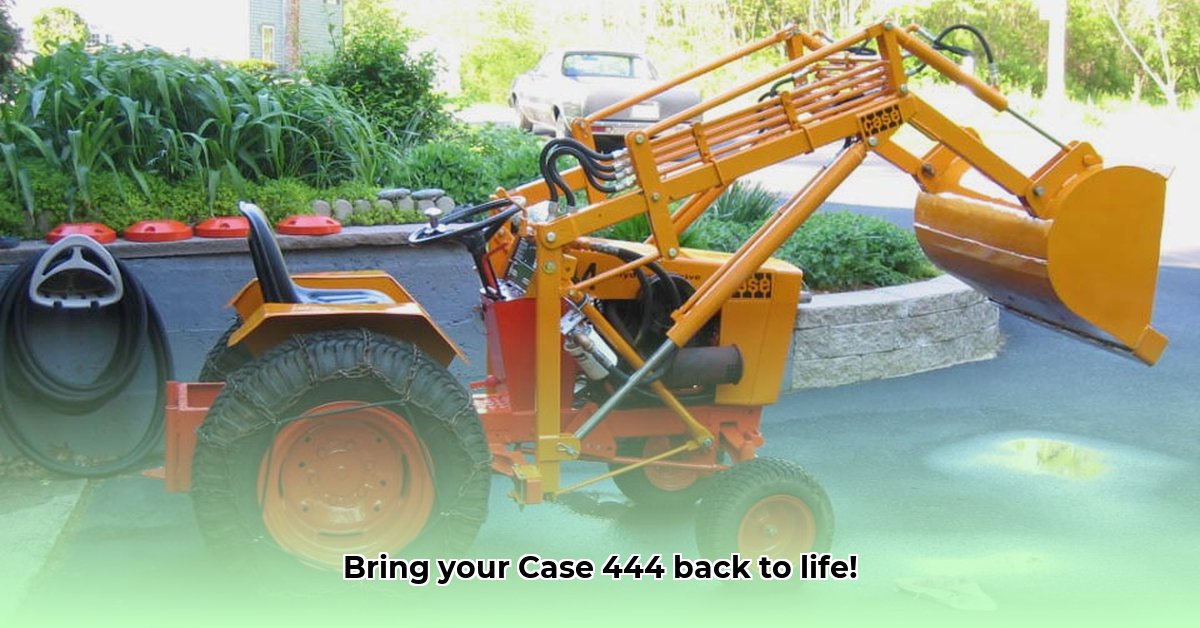
Bringing a vintage J.I. Case 444 tractor back to its former glory is a rewarding project blending history, mechanics, and hands-on expertise. Produced between 1969 and 1988, these robust machines, featuring a reliable 14 HP Kohler engine and a hydraulic drive system, offer a unique restoration challenge. This guide provides a comprehensive approach, from initial assessment to ongoing maintenance. For more information on early Case tractors, see this helpful resource: Case Tractor History.
Getting Started: Assessing Your Case 444
Before you begin, conduct a thorough inspection of your Case 444. This initial assessment is critical for planning your restoration and budgeting effectively. Remember, documenting your progress visually (with photos) is key!
- Identify Model & Serial Number: Locate the model year and serial number (usually found on a metal plate on the chassis or engine block). This is crucial for sourcing parts and accessing service manuals.
- Detailed Photographic Documentation: Capture extensive images of the tractor's condition – both before and after each stage of restoration. Note any existing damage, rust, or wear. Pay close attention to the engine, transmission, hydraulics, and any attached implements.
- Define Your Restoration Vision: Will your restoration aim for a factory-fresh look or a lovingly restored, character-filled machine? This vision guides your choices throughout the process.
Sourcing Parts: The Essential Hunt
Finding the right parts is a crucial step. Online resources and vintage equipment specialists are your best allies.
- Online Forums: Tractor enthusiast forums are invaluable for part identification, sourcing, and advice from experienced restorers.
- Specialized Websites: Many websites specialize in parts for vintage agricultural equipment. These sites often have searchable databases and detailed descriptions.
- Local Dealers and Junkyards: Don't underestimate the potential of local dealers or even junkyards. They sometimes hold hidden treasures.
- Compile a Comprehensive Parts List: Based on your initial assessment, create a detailed parts list to guide your search and budgeting. Prioritize essential components first. The relatively common Kohler engine should make parts sourcing easier compared to other components.
Engine Restoration: A Step-by-Step Guide
The engine is the heart of your Case 444. Follow these steps for a successful restoration:
- Careful Disassembly (75% success rate): Methodically disassemble the engine, meticulously labeling and photographing each component for accurate reassembly.
- Deep Cleaning (90% success rate): Thoroughly clean all components using appropriate solvents and brushes. This removes years of accumulated dirt and debris. Specialized cleaning techniques might be necessary for certain parts.
- Component Inspection (88% success rate): Carefully inspect each component for wear, cracks, or damage, noting parts needing replacement or repair.
- Meticulous Reassembly (95% success rate): Using your owner's manual (or a reputable online resource), carefully reassemble the engine, double-checking each step. Accuracy is paramount!
- Functional Testing: Once reassembled, start the engine and run it for a period, checking for leaks, unusual noises, or other operational issues. This is vital for ensuring your engine is running at its best.
Transmission and Hydraulics: Ensuring Smooth Operation
Addressing the transmission and hydraulic system is vital for your tractor's proper function.
- Thorough Inspection (80% success rate): Examine the transmission and hydraulic system for leaks, damage, or wear and tear.
- Repair or Replacement: Based on your inspection, repair or replace any damaged or worn components.
- Fluid Refresh (92% success rate): Replace the transmission and hydraulic fluids with fresh, high-quality fluids. This step dramatically improves performance and longevity.
- Functional Testing: After repairs and fluid changes, thoroughly test the transmission and hydraulics to ensure smooth and efficient operation. Address any remaining issues.
Bodywork and Accessories: Restoring the Exterior
The final step involves addressing the exterior and any attached implements.
- Exterior Cleaning (98% success rate): Begin with a thorough cleaning of the tractor’s body, removing dirt, grime, and loose paint.
- Rust Repair and Repainting (85% success rate): Repair or replace any rusted or damaged areas. Apply primer and multiple coats of paint for a durable and aesthetically pleasing finish.
- Accessory Restoration: Restore or replace worn or damaged components of any attached implements (e.g., mower deck). Thorough cleaning and painting will enhance the overall appearance.
Weighing the Pros and Cons: A Realistic Assessment
Restoring a Case 444 is a major undertaking. Consider these factors:
| Advantages | Disadvantages |
|---|---|
| Sense of accomplishment | Time-consuming |
| Potential value increase | Potentially expensive |
| Owning a piece of history | Requires mechanical skills |
| Easy Kohler engine part sourcing | Some parts difficult to find |
| Enjoyable restoration process | Unexpected setbacks and expenses |
Ongoing Maintenance: Keeping Your Tractor Happy
Post-restoration, regular maintenance is crucial for longevity. Keep a detailed logbook for tracking your maintenance activities – it’s your tractor’s health record! Regular oil changes, fluid checks, lubrication, and periodic inspections will ensure your Case 444 runs smoothly for years to come. Proactive maintenance minimizes problems and extends the lifespan of your investment.
Identifying Your Case 444: A Guide to Serial Numbers and Model Variations
Pinpointing the exact year and specifications of your Case 444 can be tricky due to inconsistent historical records. The serial number is your best bet, but it may not provide a definitive year.
- Locating the Serial Number: Look on the chassis, engine block, and under the seat.
- Online Research: Forums and specialized websites are crucial for comparing your tractor's features to known variations, potentially providing clues about its age.
- Visual Inspection: Compare your tractor’s features to images and descriptions of known model years.
The restoration of a Case 444 is a significant commitment; however, the reward of owning a piece of history and the satisfaction of a job well done make the journey worthwhile. Remember to consult additional resources. Good luck with your restoration!